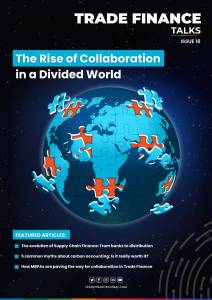Estimated reading time: 5 minutes
For ages, correspondent banking has played a vital role in the global payments system. Through correspondent banking relationships, banks gain access to a diverse range of financial products across various jurisdictions enabling them to offer cross-border payment solutions and services to their customers.
Nonetheless, in recent years major banks around the world have been terminating their long-standing correspondent banking relationships. This phenomenon, commonly known as ‘de-risking’, is fundamentally reshaping the global financial services market.
While predominantly pursued with the intention of mitigating risk exposure for financial institutions amidst growing regulatory pressures, the consequences of de-risking extend beyond the banking sector. Many countries are threatened by the loss of their connectivity to the global financial system. For smaller developing countries, de-risking is not just a banking concern, but a considerable trade issue endangering their basic human needs.
To delve deeper into the key drivers of de-risking and its real impact on global trade and developing markets, Trade Finance Global’s (TFG) Deepesh Patel spoke with Shane Riedel, Founder and CEO at Elucidate.
Unveiling the catalysts behind de-risking
The ongoing Ukraine-Russia conflict has magnified the global regulatory focus on the financial services sector, particularly in areas of financial crimes, anti-money laundering (AML), and counter-terrorist financing (CTF) regulations. In response, financial institutions have notably cut back their risk appetite.
Although the declining risk appetite and the intensifying AML/CTF scrutiny are often perceived as the main motives behind de-risking, the underlying factors are much more complex. From Riedel’s perspective, de-risking reflects a reaction to the multifaceted commercial realities in today’s financial markets.
As Riedel pointed out, “De-risking is just a response to the commercial realities of the market. The instances of genuine de-risking due to financial crime or compliance reasons, represent an astonishingly small percentage of the overall exits observed in the market.”
In addition, Riedel clarified that the primary reason behind de-risking lies in commercial decisions that are centred around the costs of regulatory compliance, saying, “In most instances, the reason that banks are consolidating their portfolios is a commercial decision, based on the cost of regulatory compliance.”
Whilst acknowledging the significance of enhancing compliance frameworks, Riedel cautioned against focusing solely on implementing additional compliance measures. Rather, he suggested exploring the systemic factors that hinder banks from effectively evaluating the commercial aspects of their correspondent banking relationships.
Aiming for more cost-effective partnerships or inclusive distribution of risks and costs across the market, he explained, “We need to look at the systemic reasons why banks can’t make the commercial elements work and how to change that.”
The economic impact of de-risking
De-risking disproportionately impacts developing economies. Particularly vulnerable are the communities that rely on these services to access financial resources and dollar liquidity from the developing world to sustain their populations.
As dollar liquidity declines, the challenge obviously demonstrates the real intersection of financial market dynamics and basic societal needs. Underscoring the fragility of such economies and the struggles faced by these nations and their SMEs, Riedel added, “In these markets, fewer opportunities are being created for SMEs who could otherwise have been more involved if the trade finance gap was better bridged or if more opportunities for international trade was available to them.”
Another often overlooked impact of de-risking is its potential to trigger underground transactions. The closure of bank accounts may force organisations and individuals to resort to cash transactions, effectively creating an environment that precludes the goals of AML/CTF regulations.
Riedel notes, “What we are seeing is the evolution of shadow banking, entities that are less regulated and less transparent. The impact of de-risking has generally been to not only remove or reduce opportunity but also to reduce transparency in the market.” The rise of shadow banking and the inadvertent promotion of untraceable transactions represents a stark paradox in the global efforts to maintain a secure financial ecosystem.
Balancing risk and accessibility
While digitisation has led to significant progress in correspondent banking, particularly in the payments and trade sectors, operational, compliance, and risk management processes remain stagnant.
Riedel highlighted that while the payments and trade sectors have successfully integrated digitisation, risk management still relies heavily on manual processes, such as manual Know Your Customer (KYC) checks, qualitative assessments, and governance procedures.
He explained, “The moment you get to the operations, compliance and risk side of the house, the processes are the same today as they were 10-15 years ago.” This disparity calls for the adoption of digitisation and automation into the compliance domain, reducing manual processes and achieving a balance between risk assessment and operational efficiency.
Riedel asserted, “The only way to address this is by bringing digitisation and automation to the commercial side.”
Furthermore, partnerships have the potential to achieve a balance between risk and accessibility. Riedel illustrated this potential with a real-world example of the collaboration between Elucidate and Dow Jones.
This partnership allows financial institutions to access quantified and objective risk scoring, supporting their compliance strategies. Riedel said, “We can take some of the most cumbersome, qualitative processes and start to put values against them.”
Similarly, various financial instruments such as Letters of Credit (LCs), can benefit from such a data-driven approach. Riedel pointed out how this approach can transform the traditional LC processes, stating, “We enable banks to pre-qualify those letters of credit by determining the riskiness of the originating bank.”
This risk-based approach helps banks to accelerate their decision-making process and enhances operational efficiency without compromising due diligence.
The future of correspondent banking
With disruptive market entrants such as digital currencies and the introduction of multi-currency payment platforms fueling competition and sparking innovative solutions, the correspondent banking sector is likely gearing up for a transformational change.
Moreover, the correspondent banking industry is continuously adopting strategic aggregation models and nesting multiple layers of aggregation to enhance operational efficiency, albeit with added complexity.
As the market navigates complex layers of payment clearing, and where multiple banks are engaged in a single transaction, the role of data and standardisation cannot be overstated. As Riedel stressed, “The role of data and standardisation becomes even more important to avoid the chaos of numerous rejected payments and ultimately more de-risking.”
























